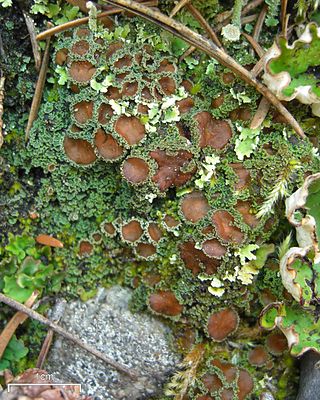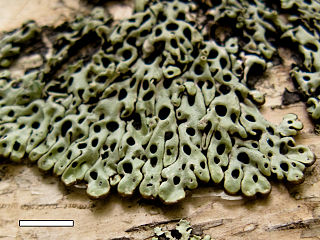
The Pannariaceae are a family of lichens in the order Peltigerales. Species from this family have a widespread distribution, but are especially prevalent in southern temperate regions.

Psoroma is a genus of lichen-forming fungi in the family Pannariaceae. The widespread genus contains about 30 species, most of which are found in south temperate regions.

Pannaria is a genus of lichen-forming fungi in the family Pannariaceae. The widespread genus contains an estimated 51 species, found primarily in tropical regions.

A cephalodium (pl. cephalodia) is a small gall-like structure found in some lichens. They occur only in lichens which contain both cyanobacterial and green algal partners. Cephalodia can occur within the tissues of the lichen, or on its upper or lower surface. Lichens with cephalodia can fix nitrogen, and may be an important contributor of nitrogen to the ecosystem.

Menegazzia is a genus of lichenized fungi containing roughly 70 accepted species. The group is sometimes referred to as the tree flutes, honeycombed lichens, or hole-punch lichens. The most obvious morphological feature of the genus is the distinctive perforations spread across the upper side of the thallus. This makes the group easy to recognise, even for those not particularly familiar with lichen identification.
Pannaria phyllidiata is a species of lichen in the family Pannariaceae. Known from Australia, it was described as new to science in 2011. It is characterised by its unique phyllidia and distinct distribution.
Gibbosporina is a genus of 13 species of foliose lichens in the family Pannariaceae. It contains species that molecular phylogenetic analysis clustered together in a clade previously referred to as the "Physma"-group. Despite their morphological differences, this group shares several uniting characteristics. They have ring-like excipular margins around the thallus; strongly amyloid internal ascus structures; well-developed perispores that feature irregular gibbae, but not verrucae ; lacks secondary compounds than can be detected by thin-layer chromatography; and have tropical distributions.
Gibbosporina bifrons is a species of foliose lichen in the family Pannariaceae. It was described as a new species in 2016 by Arve Elvebakk, Soon Gyu Hong, and Per Magnus Jørgensen. The specific epithet bifrons, meaning "two-faced", refers to the well-developed and large cephalodia that occur with the green algal photobiont. The lichen occurs in the Philippines, Solomon Islands, Malaysia, and New Caledonia.
Gibbosporina didyma is a rare species of foliose lichen in the family Pannariaceae. It was described as a new species in 2016 by Arve Elvebakk, Soon Gyu Hong, and Per Magnus Jørgensen. The specific epithet didyma, refers to the thallus being divided into a prominent cyanobiont in addition to the dominant chlorobiont, as well as to cephalodia that are sometimes divided by the developing apothecia of chlorobionts. The lichen is known from only two locations on Réunion and Mauritius; both are tropical forests at moderate altitudes, 500–600 m (1,600–2,000 ft).
Gibbosporina elixii is a species of foliose lichen in the family Pannariaceae. It is endemic to Queensland, Australia. The lichen was described as a new species in 2016 by Arve Elvebakk, Soon Gyu Hong, and Per Magnus Jørgensen. The specific epithet honours Australian lichenologist John Alan Elix. He collected the type from Mossman Gorge National Park, where he found it growing on the base of a tree in a tropical rainforest along Mossman River. It has also been found in the Cardwell Range.
Gibbosporina nitida is a species of foliose lichen in the family Pannariaceae. It was described as a new species in 2016 by Arve Elvebakk, Soon Gyu Hong, and Per Magnus Jørgensen. The specific epithet nitida, derived from the Latin nitidus ("glossy"), refers to the lustrous upper lobe surfaces. The lichen occurs in northeast Australia, Papua New Guinea, the Philippines, and Fiji.
Gibbosporina sphaerospora is a species of foliose lichen in the family Pannariaceae. It was described as a new species in 2016 by Arve Elvebakk and Soon Gyu Hong. The type was collected from Millaa Millaa Falls in Queensland, Australia, where it was found growing on fallen branches in a remnant rainforest near the falls. The specific epithet sphaerospora, which combines the Greek sphaero ("globose") with spora, refers to the spherical shape of the spores. The lichen occurs in Australia, Fiji, and Papua New Guinea.
Gibbosporina thamnophora is a species of foliose lichen in the family Pannariaceae. It was described as a new species in 2016 by Arve Elvebakk and Per Magnus Jørgensen. The type was collected from Eungella National Park in Queensland, Australia, where it was found growing on bark in a tropical rainforest near Broken River. The specific epithet thamnophora combines the Greek thamnos ("shrub") and -phora ("carrier"), and refers to the finely branched, shrubby cephalodia that are "carried" by the chlorobiont. The lichen occurs in Australia and Papua New Guinea.
Arve Elvebakk is a Norwegian mycologist and professor working from the Arctic University of Norway in Tromsø. He has published widely on Arctic biology, and climatology. Additionally, he collaborates with many mycologists across the world, and has published names for lichens in Australia, New Zealand, the South Pacific, and South America, and the Antarctic.
Degelia neozelandica is a species of foliose lichen in the genus Degelia.
Pannaria minutiphylla is a species of lichen in the family Pannariaceae, described as a new species in 2013 by Arve Elvebakk. The species is similar to Pannaria phyllidiata, but can be distinguished by its smaller phyllidia and ascospores that are elongated to ellipsoid.
Hispidopannaria is a genus of lichen-forming fungi in the family Pannariaceae. It comprises two species, both found exclusively in southern South America. The genus is characterised by its large, leafy structures covered with stiff, bristle-like hairs, giving the lichen a fuzzy appearance. These lichens form symbiotic relationships with both green algae and cyanobacteria, allowing them to photosynthesise. Hispidopannaria was established as a distinct genus in 2020, based on DNA analysis that showed it to be genetically distinct from the closely related genus Pannaria. The two known species inhabit different ecological niches: H. hispidula is found in temperate rainforests across Chile and Argentina, primarily growing on tree bark, while H. dasyclada is endemic to Robinson Crusoe Island in Chile, where it grows on rocks and on soil.
Phormopsora is a fungal genus in the family Pannariaceae. It comprises a single species, Phormopsora isabellina. The genus was proposed in 2020 based on molecular and morphological studies of a lichen previously classified in the genera Psoroma and Pannaria. Phormopsora is characterised by its large, scale-like structures called squamules that form pale grey rosettes, and by the presence of unique lichen substances not found in other members of its family. The species is primarily found in southern South America, particularly in Chile, where it grows on the trunks of evergreen Nothofagus trees in humid, temperate rainforests. Its distinctive features include well-developed structures containing nitrogen-fixing cyanobacteria, and spores with a distinctive outer wall that has irregular swellings and thread-like extensions at the tips.
Joergensenia is a fungal genus in the family Pannariaceae. It comprises a single species, Joergensenia cephalodina, which is a corticolous (bark-dwelling), squamulose lichen found in southern South America.
Gudelia is a fungal genus in the family Gloeoheppiaceae. It comprises the single species Gudelia mexicana, a little-known rock-dwelling lichen found in southwest Mexico and described in 1995.



